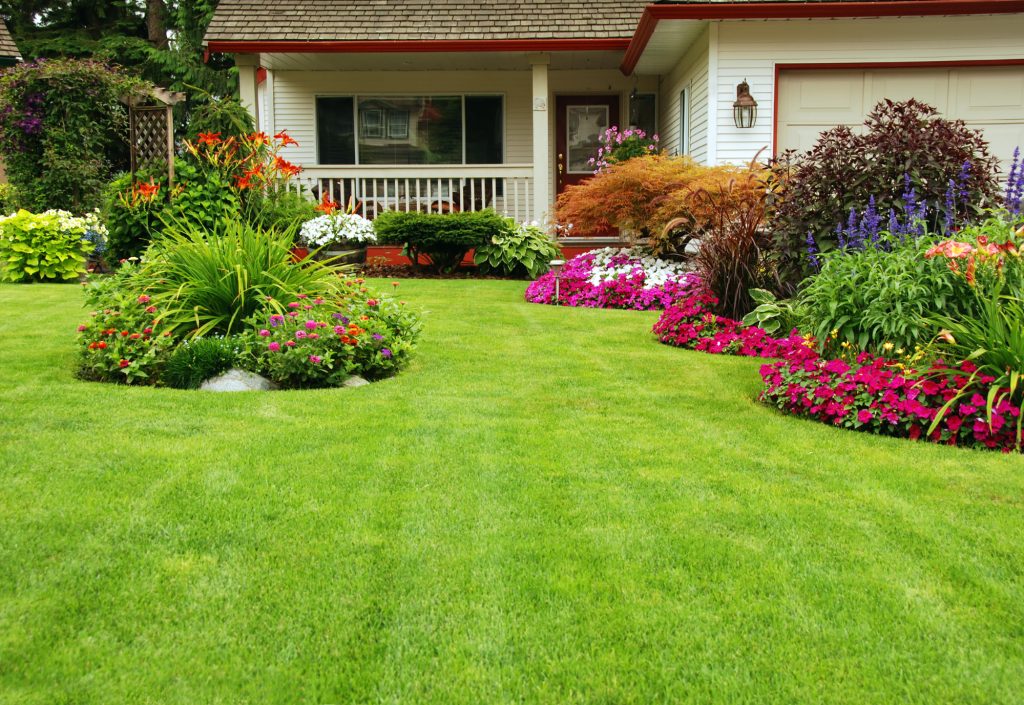
It’s what every homeowner dreams of: a perfect, healthy lawn. A great lawn sets off your home’s facade beautifully or makes the perfect setting for a backyard escape. So what are those magic tips for that coveted healthy lawn? Luckily for you, it isn’t rocket science! Growing a thick, healthy, green lawn takes some time and attention but is totally attainable. To keep things as simple as possible, we’ve broken it down to the top 5 tips to help you grow the lawn of your dreams.
1. Starting with healthy soil
The very first step to a healthy lawn is healthy soil. You’ve got to start at the very bottom to see long-term results! And you can learn a lot when you test your soil. Soil testing is a simple process that yields big returns. It will give you an accurate starting point for your lawn’s unique needs, as well as recommendations to fix any underlying problems. If you are new to soil testing, contact your local extension office. They can provide you with simple kits and information to get you started.
Testing soil reveals its pH level and other conditions. By following test result recommendations, you can improve your soil without guesswork. For example, if your soil pH is too low, your grass won’t be able to take up the nutrients it needs. Testing is an easy way to learn if your lawn needs lime or other soil amendments to restore pH balance and nutrient availability. Balancing out these needs will help your grass grow thick and lush, just like you dream about.
2. Turf selection
Just as it’s vital to start with healthy soil, the turf you put on that soil makes a huge difference. To sustain a healthy lawn, you need to make sure you choose a turf variety that’s right for your climate. Temperatures, moisture levels, and usage will impact how well your lawn fares throughout the year. Make sure you choose the lawn variety that meets your needs and location. In the southeast, Bermudagrass and Zoysiagrass are very popular. Another option, especially for the slightly cooler areas of Zone 7, such as northern Georgia, is Centipede grass.
Bermudagrass
TifTuf Bermuda and TifGrand Bermuda are two popular varieties of turf. TifTuf™ Bermudagrass was developed specifically to stay healthy throughout long, hot summers. This fine-textured, green leaf beauty uses 38% less water than similar grass cultivars. It also has a high shade tolerance, which helps prevent dead spots caused by uneven sunlight. It’s fantastic year-round because it greens up early in spring and it stays greener further into the cool autumn season.
When you choose your turf variety, climate is only one factor. Be sure to consider your intended use. Bermudagrass offers superior color and density, but it also offers high resistance to traffic and fast recovery from wear and tear. That makes it an ideal choice for a yard that will get lots of use from kids, pets, and summer activities.
TifGrand® Bermudagrass is known for its dark green color and fine leaf blades, but above all, it is incredibly durable. This Bermudagrass thrives well in shade or full sunlight, yet another reason why homeowners, sod producers, and turf breeders love it. It’s also a great option for those looking for a hearty lawn that’s tougher to damage. TifGrand offers superior shade tolerance, wear tolerance, and sheer strength over all other bermudagrass cultivars. It is also very disease-resistant, drought-resistant, and capable of rebounding from heavy use.
Zoysiagrass
If you’re picturing a lawn as the crown jewel of a home, you’re probably thinking of Zoysiagrass. Zeon® Zoysiagrass has the ‘wow’ factor that makes it the envy of neighbors, sod producers, and turf breeders alike. In fact, Zeon is considered to be the most beautiful of all the warm-season turfgrass cultivars. It’s a luxurious and resilient turf grass ideal for use in the “sunbelt” areas of the country. It even stretches further into the northeast region than many other warm-climate varietals!
While Zeon is a strong Zoysiagrass, JaMur™ is one of the most drought-resistant Zoysiagrass. It’s tough enough to let your kids and dogs play on it, yet it will retain its gorgeous blue-green appearance and lush, dense texture. It’s so dense it even chokes out weeds. Many homeowners love the idea that you can own a cultivar so beautiful, that still requires so little work on your part.
3. Feeding & watering tips for a healthy lawn
Fertilizing
After turfgrass selection, fertilization is the most important factor in growing a lush, dark green lawn. To encourage green growth, choose a lawn fertilizer with a high percentage of nitrogen and a low percentage of phosphorus.
When your lawn lacks nitrogen, it can be susceptible to a weed invasion. You will also notice a much lower number of grass clippings than usual after you mow the lawn. Some of the most common visible signs of a nitrogen deficiency include yellowing grass, plus slow growth and low density. A simple way to add nitrogen to your soil is by leaving grass clippings on the lawn.
It’s important to fertilize your lawn regularly, starting in the spring and ending in late autumn. In the hottest months of summer, you can pull back on fertilizing as often. However, it’s a good idea to continue to monitor your soil levels to ensure your turf is getting the nutrients it needs. During the growing season, you can expect to spread fertilizer over your lawn every six to eight weeks.
Watering
To maintain a healthy lawn you should water with care. That means you should water regularly, but make sure to water deeply enough to reach roots. You should water your lawn deeply two or three times a week instead of lightly daily. Apply enough water to soak the top 6 to 8 inches of soil, about 1 inch of water across the lawn. You should also water early in the day to avoid creating issues like pests and mold. Just as underwatering can cause your lawn to go dormant and eventually die, overwatering can damage roots and cause ongoing issues.
4. Mowing properly
Mowing your lawn has a direct impact on its appearance. Grasses should not have more than one-third of their height cut off at once. When grass is actively growing, it will usually need to be mowed at least once a week to keep it at the healthiest height. Mow with sharp blades to avoid tearing grass leaves. While mowing once a week is required, mowing slightly more often can have benefits. Grass will be thicker when you frequently mow it, as it will grow near the roots. Mowing can also improve lawn health since frequent trims help the lawn effectively make its food.
5. Avoiding damage to your lawn
There are many ways to damage your lawn, so being cognizant of these causes can help you protect your lawn. Unhealthy lawns will have rigid blades that will break apart when stepped on or handled and will retain footprints after being walked on. That’s the last thing you want! We’ve already covered fertilizing, watering, and mowing. But there are other ways you may inadvertently damage your lawn. Leaving clutter on the lawn, from kiddie pools to chairs and tables, compacts the soil beneath the lawn and damages the grass. Pets can also damage your lawn. If you can train your dogs to relieve themselves elsewhere, do your best to rinse down the lawn as soon as you can.
The final word on tips for a healthy lawn
A healthy lawn comes down to how well you plan and care for your turf. Preparing your soil, choosing the right turf, and following through on regular maintenance will give you the lawn of your dreams.
